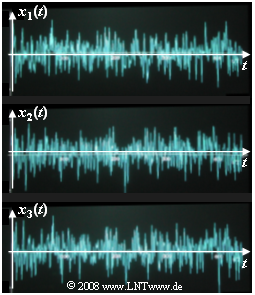Exercise 4.15Z: Statements of the Covariance Matrix
Let be given the two Gaussian random variables $u$ and $v$, each zero mean and with variance $\sigma^2 = 1$.
From these, three new random variables are formed by linear combination:
- $$x_1 = A_1 \cdot u + B_1 \cdot v,$$
- $$x_2 = A_2 \cdot u + B_2 \cdot v,$$
- $$x_3 = A_3 \cdot u + B_3 \cdot v.$$
Assuming that in all cases considered $(i = 1,\ 2,\ 3)$ holds:
- $$A_i^2 + B_i^2 =1.$$
The graph shows the signals $x_1(t)$, $x_2(t)$ and $x_3(t)$ for the case to be considered in the subtask (3):
- $A_1 = B_2 = 1$,
- $A_2 = B_2 = 0$,
- $A_3 = 0.8, \ B_3 = 0.6$.
The correlation coefficient $\rho_{ij}$ between the random variables $x_i$ and $x_j$ is given as follows:
- $$\rho_{ij} = \frac{A_i \cdot A_j + B_i \cdot B_j}{\sqrt{(A_i^2 + B_i^2)(A_j^2 + B_j^2)}} = A_i \cdot A_j + B_i \cdot B_j.$$
Under the assumption implicit here $\sigma_1^2 = \sigma_2^2 = \sigma_3^2 = 1$ the covariance matrix $\mathbf{K}$ is:
- $${\mathbf{K}} =\left[ K_{ij} \right] = \left[ \begin{array}{ccc} 1 & \rho_{12} & \rho_{13} \\ \rho_{12} & 1 & \rho_{23} \\ \rho_{13} & \rho_{23} & 1 \end{array} \right] .$$
This is identical to the correlation matrix $\mathbf{R}$ for zero mean random variables.
Hints:
- The exercise belongs to the chapter Generalization to N-Dimensional Random Variables.
- Some basics on the application of vectors and matrices can be found on the pages Determinant of a Matrix and Inverse of a Matrix .
Questions
Solution
- Statement 2 describes the case considered in the graph where two quantities $($here: $x_1$ and $x_2)$ are uncorrelated, while $x_3$ has statistical bindings with respect to $x_1$ $($about the quantity $u)$ and also with respect to $x_3$ $($due to the random variable $v)$ .
- On the other hand, the combination $\rho_{12} = \rho_{13} = \rho_{23} = 0$ is not possible with the structure given here. For this, one would need a third statistically independent random variable $w$ and, for example, $x_1 = k_1 \cdot u$ , $x_2 = k_2 \cdot v$ and $x_3 = k_3 \cdot w$ would have to hold.
- The third statement is also not true: If $x_1$ and $x_2$ are uncorrelated and at the same time also $x_1$ and $x_3$, then no statistical bindings can exist between $x_2$ and $x_3$ either.
- In general, however, both $\rho_{12}$ and $\rho_{13}$ will be different from zero.
- A very simple example of this is considered in the subtask (2) .
(2) In this case, the quantities $x_1 = x_2$ are completely $($to $100\%)$ correlated.
- With $A_2 = A_1$ and $B_2 = B_1$ we obtain for the joint correlation coefficient:
- $$\rho_{12} = A_1 \cdot A_2 + B_1 \cdot B_2 = A_1^2 + B_1^2 \hspace{0.15cm}\underline{=1}.$$
- In the same way, with $A_3 = -A_1$ and $B_3 = -B_1$:
- $$\rho_{13} = A_1 \cdot A_3 + B_1 \cdot B_3 = -(A_1^2 + B_1^2) \hspace{0.15cm}\underline{=-1 \hspace{0.1cm}(= \rho_{23})}.$$
(3) With this set of parameters, $x_1$ is identical to the random variable $u$, while $x_2 = v$ holds.
- Since $u$ and $v$ are statistically independent of each other, we get $\rho_{12} \hspace{0.15cm}\underline{ = 0}.$
- In contrast, for the other two correlation coefficients:
- $$\rho_{13} = A_1 \cdot A_3 + B_1 \cdot B_3 = 1 \cdot 0.8 + 0 \cdot 0.6 \hspace{0.15cm}\underline{ = 0.8},$$
- $$\rho_{23} = A_2 \cdot A_3 + B_2 \cdot B_3 = 0 \cdot 0.8 + 1 \cdot 0.6 \hspace{0.15cm}\underline{ = 0.6}.$$
- For a (very well) trained eye, it can be seen from the graph on the information page that the signal $x_3(t)$ has more similarities with $x_1(t)$ than with $x_2(t)$.
- This fact is also expressed by the calculated correlation coefficients.
- Don't be frustrated, however, if you don't recognize the different correlation in the signal courses.
